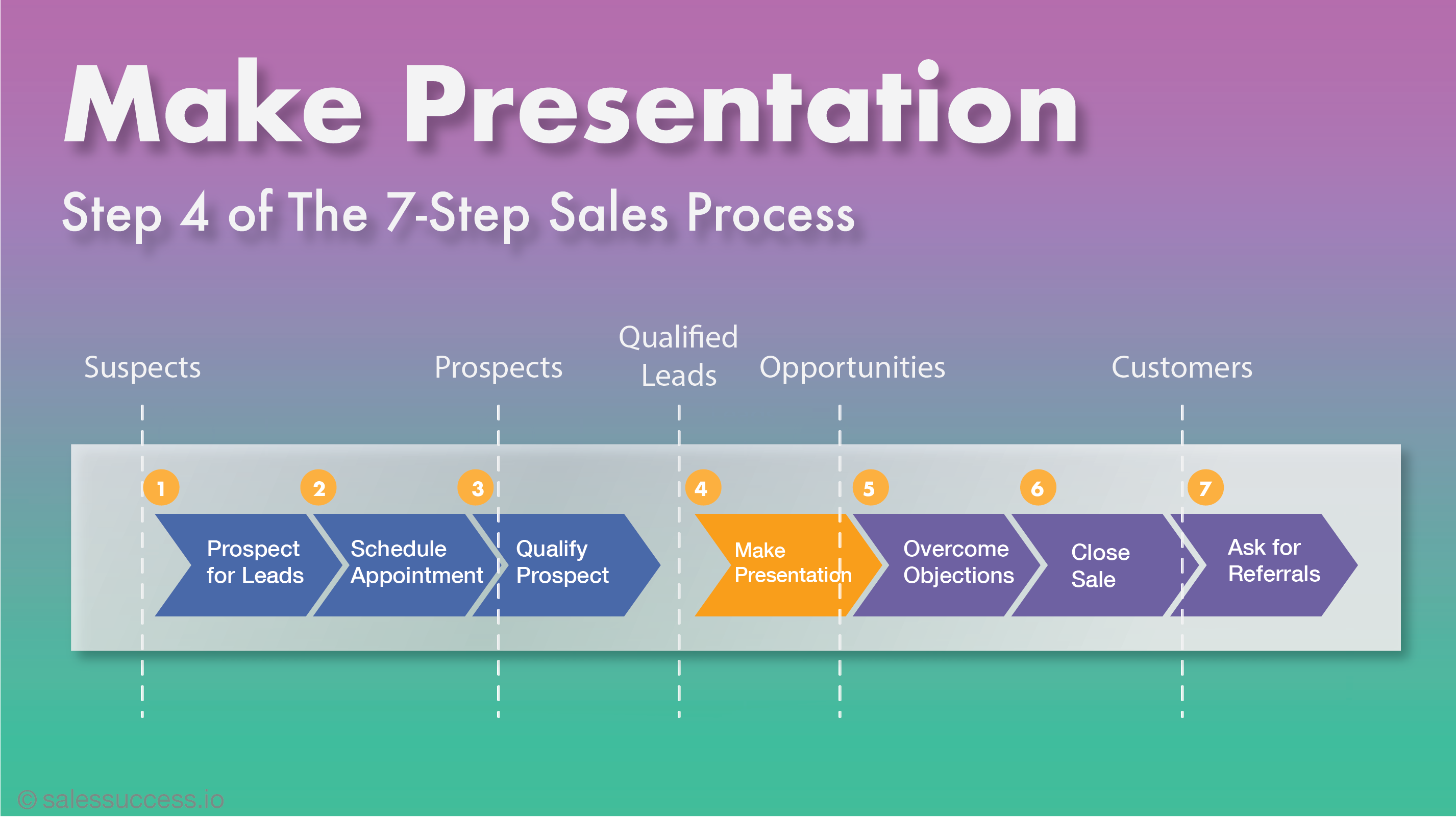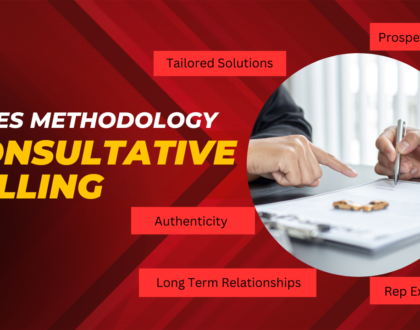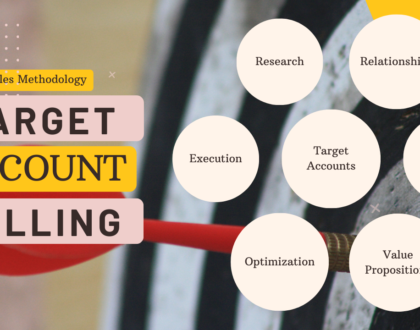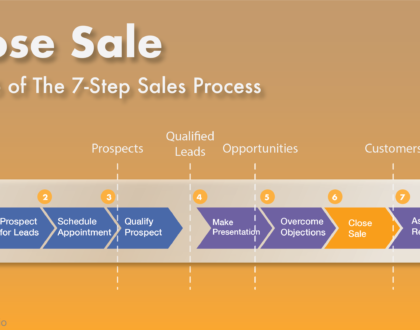Making Presentation: Tips for a Compelling and Engaging Delivery

![]()
We are continuing our blog series on the universal end-to-end sales process. In the first step of the process, you prospect for leads.
Next, you set an appointment with those leads. In the third step, you conduct a qualification and discovery call.
After that, you make your sales presentation to the prospect. You can make or break the deal depending on how you execute this step.
Here are the 7 keys to making a great sales presentation that seals the deal for you.
1. Short, visual, and two-way
3. Value proposition and differentiation
4. As-is, to-be, and going from here to there
5. Social proof and case studies
Short, Visual, and Two-Way
Cut your sales presentation to the core. Keep it short and get to the point otherwise, you will risk losing the attention of your audience.
Avoid long-winded discussions. Be clear about your key points and practice how to make them quickly before your meeting with the prospect.
Make the presentation visual. Use visual aids to cut down on text and convey the narrative.
A visual presentation captivates the audience’s attention and hooks them to listen to you. On the contrary, text diverts their attention away from what you are saying towards reading it.
The other aspect of keeping your presentation short is to give yourself ample time to engage your prospect in a two-way dialogue. Listen to them as you make your key points.
Ask questions to get them talking and involved.
Take notes of their comments, queries, concerns, and objections. Make sure you address them without fail. Let your prospect know you are sincere in engaging with them.
Tailored Pitch
Do not use your company’s standard sales presentation deck as is. Avoid the trap and easy way out of using a generic presentation and saying the same thing.
Instead, invest the time upfront to tailor your pitch, making it relevant and compelling, and adapting the discussion of your product or service to each prospect.
Modify the generic presentation to include the specific points that are unique to the prospect.
One basic thing to do when tailoring sales presentations is to place the prospect’s company logo on your slides. It is a clear indication to them that you have done your homework on their business.
The more impactful thing to do is to relate the key slides to their situation.
Based on findings from the qualification and discovery call with them, you demonstrate how your product or service addresses their specific problems.
Note here that the demo of your product should not be an “A to Z” demo. Instead, you should demonstrate those specific features and functionalities that are relevant to addressing their problems.
Note also that the product demo could be used effectively as part of the qualification and discovery call to round out or complete your needs assessment.
Authoring your own content and making your own slides is a powerful persuasion tactic.
You not only present with conviction because you have authored it but you also come across as an expert and elevate yourself in the eyes of the prospect.
Value Proposition and Differentiation
Your sales presentation should be less about the features of your product or service and more about its benefits and value proposition to the prospect.
The value proposition is an effective, hard-hitting statement of why the prospect should buy your product or service and associate themselves with your company’s brand.
The value proposition is the most important marketing message that sales teams everywhere use. You make sure to cover it and leverage it to the fullest in your presentation.
Your value proposition must help you accomplish two other things in your presentation. It should address the “Why Us” question for the prospect.
In other words, the value proposition should differentiate your product against competitors in the prospect’s mind.
Your major competitor in many sales situations is the prospect’s status quo. Your value proposition must compel them to move away from it and commit to the change that your offering represents.
As-Is, To-Be, and Going from Here to There
As noted earlier, you must get to the point in your presentation. That point is the change your prospect undergoes with your product or service. It’s a change for the better!
Present the as-is or before and to-be or after scenarios. For the as-is scenario, pinpoint their pain and the risk of continuing with the status quo.
In the discovery call, you helped them realize they have a problem. You are simply recalling that here as part of the as-is scenario.
For the to-be scenario, project the gain the prospect will derive from your product or service. Point out the outcomes they would achieve by adopting your offering and undergoing the change.
Describe the actions they have to take “to go from here to there.” Highlight the benefits of your product or service that would enable those actions.
Social Proof and Case Studies
Your presentation must provide concrete evidence of your claims and promises to the prospect of enabling change.
You should provide proof of other similar companies that are customers using your product or service and the results they have achieved (“value proof”). You could also provide evidence in the form of market share or the total customer base your company has gained for the product or service (“volume proof”).
If you can show data on the pace at which your company is penetrating the market and growing, then even better as it will create a sense of urgency in the prospect.
Lively Delivery
How you deliver the presentation makes a world of difference to your chances of winning the deal. Your prospect must go, “I want to do business with this salesperson” by the end of your presentation.
You must be lively in your presentation style whether it is in person or remote over the Internet and web conference. Show enthusiasm and be energetic.
Use your voice effectively and vary your modulation. Avoid the pitfall of talking about your product or service in a monotonous tone because of your familiarity with it.
Your style cannot cause your prospect to lose interest in your presentation and risk the sale. Do practice runs with team members within your organization and record your presentation.
Review what you sound like as you discuss your product or service and improvise.
Pilot or Trial
At the end of the presentation, you must offer a free trial or a pilot of your product or service where it makes sense.
This is especially the case when selling an intangible product or service, such as software, apps, games, and analytics.
If you can get the customer to agree to the free trial or pilot, then you have a foot in the door. You would have essentially sidelined competition.
Now, the deal is for your company to lose from thereon!
Conclusion
In conclusion, making a presentation can be nerve-wracking, but with the right preparation, practice, and delivery, it can become a powerful tool in your arsenal to close more deals and achieve sales success.
Remember to focus on your audience, use visual aids effectively, and tell a story that engages and inspires.
By following these tips, you can become a confident and effective presenter, and win over even the toughest prospects.



